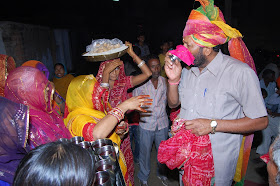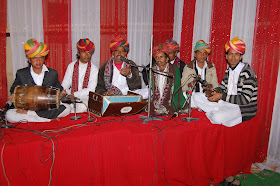RAJPUT WEDDING CUSTOMS & RITUALS
Rajputs traditionally have their own distinct individual rituals of marriage, as marriage is one of the most important events in life. It is relation which is created for seven generations between the two families of the bride and the groom. Rajputs are the only clan perhaps who have carried forward the tradition of the royal family weddings, the grooms' riding of elephants and the brides' decked up in diamonds and other precious stones. The Rajput marriages, as a rule, are grand traditional affairs.

RAJPUT WEDDING CUSTOMS & RITUALS
» Pre - Marriage Ceremonies : Engagement, Ganpati Sthapana, Pithi Dastoor, Mehfils, Janeva Ceremony, Palla Dastoor, Toran
» Marriage Ceremonies : Granthi Bandhan, Paani Grahan, Phera Ceremony, Satapadi, Bidai
Matchmaking
» Pre - Marriage Ceremonies : Engagement, Ganpati Sthapana, Pithi Dastoor, Mehfils, Janeva Ceremony, Palla Dastoor, Toran
» Marriage Ceremonies : Granthi Bandhan, Paani Grahan, Phera Ceremony, Satapadi, Bidai
Rajput gives special attention to the matchmaking aspect of the marriage. The match between a boy and girl is made by taking into consideration many important facts. The family is the first and the foremost significant of all factors. Every care is taken to ensure that the alliance is perfect. The status of the families has to be at par. It is also very important that the bride and the groom hail from separate clans. The horoscopes have to be approved and matched by the family astrologer. Rajputs prefer to marry within the community only. However, exceptions are made if either the bride or the groom comes from a royal family.
Wedding Costumes
Bridal Wear
The Rajput bride wears a resplendent traditional Rajputi poshak (The Bridal dress) for the wedding ceremony that is usually red in colour but you will also find orange, yellow, gold or pink poshaks being worn. There are certain traditional items of jewellery worn by the bride for the occasion that also have their own significance.A bright parrot green is a particular favorite of a particular Rajput clan. A lot much jewellery adorns the bride as well. There would be the Rakhdi (a circular piece of jewellery for the forehead), the Sheesphul as headgear, the Aad as a thick neck hanging, hanging earrings, the Timaniyaan (a choker studded with uncut diamonds), the Chooda (a set of ivory and gold bangles), the Bajuband (gold and stone-studded armlets) at elbow on arms, the Poonchis and the Bangdis as thick golden bangles in arms, the Hathphuls on hands, the Pajeb or Payal (gold anklets) and the Bichhiya (gold toe-rings for the feet) and finally, there is the Nath (the stone-studded nose-ring).
Interesting Facts:
The 'Rakhdi', a circular piece of adornment worn on the forehead in the parting of the hair signifies that the bride must 'walk on the straight line' while the danglers on her ears advise her not to listen to gossip.
The 'Timaniyaan', which is a choker encrusted with uncut diamonds, tells her that she should always bow her head in humility.
The 'Chooda' that is a set of ivory and gold bangles, reminds her to give to charity.
The anklets tell her to put the 'right foot forward' while the nose ring reminds her not to spend more than her husband can afford.
The wedding dress and the Aad is gifted by the groom's side to the bride.

















ટિપ્પણીઓ નથી:
ટિપ્પણી પોસ્ટ કરો
નોંધ: ફક્ત આ બ્લોગનો સભ્ય જ ટિપ્પણી પોસ્ટ કરી શકે છે.